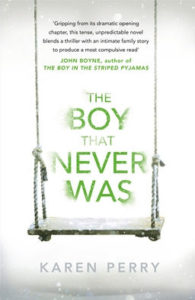Books
Inside Audio: The Boy That Never Was
How do you turn a thrilling crime novel into a thrilling audiobook? How do you retain the suspense, the ambiguity and the tension? We asked Roy McMillan, Audiobook Producer at Penguin Books to provide us with a few insights into the processes involved in bringing the text to life, and how the team approached a particularly complex book, Karen Perry’s chilling mystery The Boy That Never Was.
‘It starts with the text, and ends with something more than just the text.
Starting with the text must seem the most obvious thing in the world, and in many ways it is; but making audiobooks is not just about reading the words out loud (though it is that, too). It’s about matching the listening experience to the work, making the audience respond to the story the way that the readers do; in fact, sometimes, doing it better. There is an intimacy about audio that makes it compelling, and having a story read to you immediately gives it a dramatic, performed, edge.
But it starts with the text. What is the story? Who is telling it? How can we best do that in audio? And how do you pronounce Lagavulin or Aughrim or Siaghin or Petrie?* The first point is casting. Should the narrator be male or female, old or young? Do they need to come from a particular place? And the tone – what is the feel of the book, the style? Is it funky or dark or lightly humorous or straight and threatening? Is it fluid, relaxed, knowing? How do we get that across?
Then we start looking for the voice that will best bring the whole thing to life, that can be all those things – whatever they may be – as well as the forty different characters from Ireland and England and Algeria and elsewhere. We use people we’ve worked with before, people whose work we’ve liked, recommendations from voice agents, someone we’ve heard on the radio or reading other books or on stage or TV (though beware of this – many a gifted actor is not a good narrator). If we can, we send a shortlist to the author for approval; then we get going.
With The Boy That Never Was by Karen Perry, we had one obvious issue. Well, four, really. There are four different narrators. The first is the usual third-person omniscient narrator who opens the story and sets the scene.
Then there is Harry, one of the two central roles. Irish, artistic, flawed.
Then his wife, Robin. Free-spirited but bound by her life-choices and the terrible tragedy that undercuts the whole story.
And then the final voice – the other man, Garrick.
 This multiplicity makes for tremendous listening. It instantly makes the words feel as though the person is actually present, is there, telling you their story. They carry an emotional weight, and a good reader can make the words ring with all of their resonances and implications. There are moments when the performance makes the book everything you want it to be – not just the words, but the feeling, the personality, the involvement of it. You are with that person. This happens just as much with single-voice, third-person narratives (I’d recommend The Gingerbread House and The Cinderella Girl by Carin Gerhardsen, both beautifully read by Candida Gubbins – and both touching, moving and thrilling), but it’s a delight when you have the chance to do a multi-voice recording: creating the differences between the voices, then snapping into someone else’s perspective, playing with the directness of the spoken word.
This multiplicity makes for tremendous listening. It instantly makes the words feel as though the person is actually present, is there, telling you their story. They carry an emotional weight, and a good reader can make the words ring with all of their resonances and implications. There are moments when the performance makes the book everything you want it to be – not just the words, but the feeling, the personality, the involvement of it. You are with that person. This happens just as much with single-voice, third-person narratives (I’d recommend The Gingerbread House and The Cinderella Girl by Carin Gerhardsen, both beautifully read by Candida Gubbins – and both touching, moving and thrilling), but it’s a delight when you have the chance to do a multi-voice recording: creating the differences between the voices, then snapping into someone else’s perspective, playing with the directness of the spoken word.
Different books demand different approaches. We’ve used FX – especially with children’s books – as a way of creating aural illustrations (have a listen to any of the Dahl children’s stories, or Danger is Everywhere), and we often add something to the voice of the narrator if the text in the book is set with a different font, for instance. In one case, the text on a page of a book set in a London summer was shaped to appear like an apple tree. So the actor read the words in a suitably dreamy way, and we added distant cars, and birdsong and a whisper of wind in the tree’s branches to create the equivalent sense of difference and warm laziness. In another book, there were quotations from Sigmund Freud. In the print edition, these were indented and in a different typeface, so you could see they were quotations. For the audio, we asked the narrator to adopt a slight Austrian accent, but we also changed the sounds of the voice a bit afterwards, making it higher-toned, and added a bit of hiss; the result was that it sounded like a really old recording of Freud, and perfectly captured the feel of the written version.
With thrillers, detective stories and the like, there is also the problem of keeping certain things secret (don’t panic – no spoilers here). Imagine a book where there is a serial killer, and the killer is (unbeknownst to the reader) a female from Manchester. If a writer puts in a diary entry or a letter from the killer, you can’t tell that it’s a female nor where she’s from. But how do you get the actor to read that and maintain the suspense, the uncertainty? However we do it (having a female narrator throughout, disguising the voice post-recording, ensuring ambiguities are maintained elsewhere), we know we have to make it work for the listener in exactly the same way that it would for the reader.
Not all books have unusual formatting or multiple narrators, and not all audio versions need cutesy editing or many actors or a team of effects people. But all of the decisions we make about how to do the audio version take their cue from the book. We create the best, most apt, audiobooks in the way that brings those stories most vividly to life. It is all about the text. But the results are immersively, engagingly, ear-lovingly more than that.
*lag-uh-VOO-lin; OHK-rim; see-yah-HHeen (‘HH’ like the ‘ch‘ of ‘loch’); PEE-tree, since you ask, and also because I get really, really irritated when people don’t tell you how to pronounce something. How often do you NOT want to know how to pronounce a word?’
The Boy That Never Was is out now in audiobook, hardback and ebook formats. It is available in paperback from 4th December.


Please note: Moderation is enabled and may delay your comment being posted. There is no need to resubmit your comment. By posting a comment you are agreeing to the website Terms of Use.